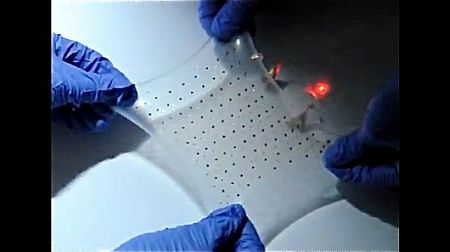(单词翻译:单击)
听力文本
This is Scientific American — 60-Second Science. I'm Christopher Intagliata.
The flat lithium ion batteries that power smartwatches are built by stacking the battery components: positive and negative electrodes, current collectors and a separator. It's akin to piling up sheets of paper—you get a stack that you can bend or roll—but you can't stretch it.
But now researchers have designed what could be a much friendlier battery for wearables. One that's bendy and stretchy, instead of a little brick. They built the bendy battery by starting with a coiled wire, sort of like a slinky—then layered the traditional battery components—electrodes, and all that—on the coil, to build a silver–zinc based battery. And the result?
"Once the battery is flexed it experiences very minimum stresses. You can imagine flexing the slinky, you can easily flex it." Alla Zamarayeva, a materials scientist at U.C. Berkeley. "That's why we were able to flex this battery for 17,000 times while there was cycle in it, in situ, without decreasing electrochemical performance."

She and her team built even stretchier batteries using serpentine designs—imagine squiggly lines of battery, embedded in a transparent polymer that looks like a band-aid. When you pull the ends of the Band-Aid, the squiggle elongates—offering stretchiness at larger scales. The study is in the journal Science Advances.
Zamarayeva's co-author Aminy Ostfeld helped integrate the bendy battery into an energy-storage bracelet. And it has a feature you won't yet find on the Apple Watch: solar cells. "Especially as more and more of these kinds of devices are being developed and we have more and more of them per person, it's going to start getting pretty impractical for us to plug in every single one of them." If their ideas are commercialized, they could give wearables designers a lot more flexibility to innovate.
Thanks for listening for Scientific American — 60-Second Science Science. I'm Christopher Intagliata.
参考译文
这里是科学美国人——60秒科学。我是克里斯托弗·因塔利亚塔。
智能手表使用的锂离子电池是由电池组件叠加制成:正负电极、集电器和隔膜。这就像把纸叠起来,你可以将纸堆弯曲或卷起来,但是不能拉伸它。
不过,现在研究人员设计出了一种更适合可穿戴设备的电池。这种电池可以弯曲和拉伸,而不再是像小砖块一样。为制造可弯曲的电池,研究人员先找来了一根有点像弹簧的线圈,然后将电极等传统电池组件放到线圈上,制作出一个银锌电池。结果呢?
“这种电池承受非常小的压力就可以被弯曲。你可以想象一下弄弯弹簧的情况,很容易就会使其弯曲。”加州大学伯克利分校的材料科学家艾拉·扎马拉耶雅说道。“这就是为什么内部有线圈的电池可以弯折1.7万次,还能不损失电学性能。”
她和她的团队使用蛇形设计来制造更有弹性的电池,想象一下弯曲的电池,被嵌入看起来像创可贴的透明聚合物里。当你拉“创可贴”的两端时,弯曲的电池被拉伸,这大幅提高了电池的伸展范围。这项研究发表在《科学进展》期刊上。
扎马拉耶雅的合著者艾米尼·奥斯特菲尔德将可弯曲电池应用到能量存储手镯中。而且它还有一个苹果手表至今都不具备的功能:太阳能电池。“特别是随着此类设备越来越多的被开发出来,我们每个人拥有的设备也越来越多,给每个设备都插上电源充电也越来越不现实。”如果将她们的想法商业化,那她们将给可穿戴设备设计师的创新带来更多的灵活性。
谢谢大家收听科学美国人——60秒科学。我是克里斯托弗·因塔利亚塔。
译文为可可英语翻译,未经授权请勿转载!
重点讲解
重点讲解:
1. be akin to 相似的;类似的;
例句:Mallett says this is akin to murder.
马里特说这和谋杀没什么两样。
2. pile up (使)堆放;(使)堆积;(使)成堆;
例句:Do your work every day;otherwise, it will pile up.
今天的事要今日完,否则事情会堆起来。
3. in situ 在原地;在原来的位置;
例句:Major works of painting, sculpture, mosaic and architecture were examined in situ in Venice.
重要的绘画、雕塑、镶嵌画和建筑作品都在威尼斯原地得到了仔细检查。
4. plug in (将插头插入插座)给…接通(电源);
例句:They plugged in their tape-recorders.
他们给录音机接上了电源。


